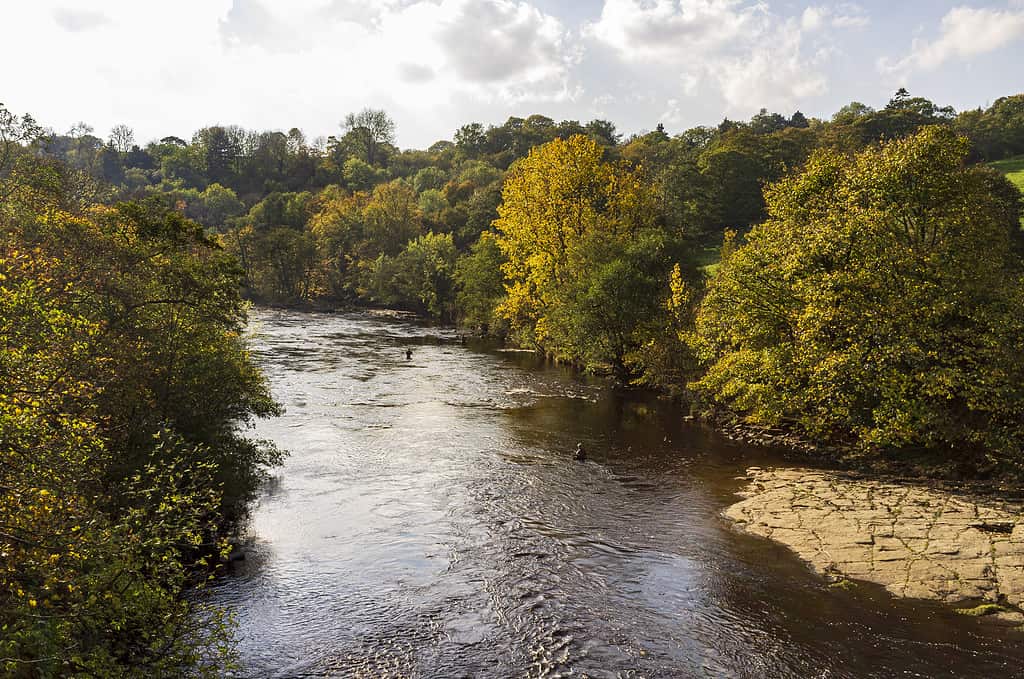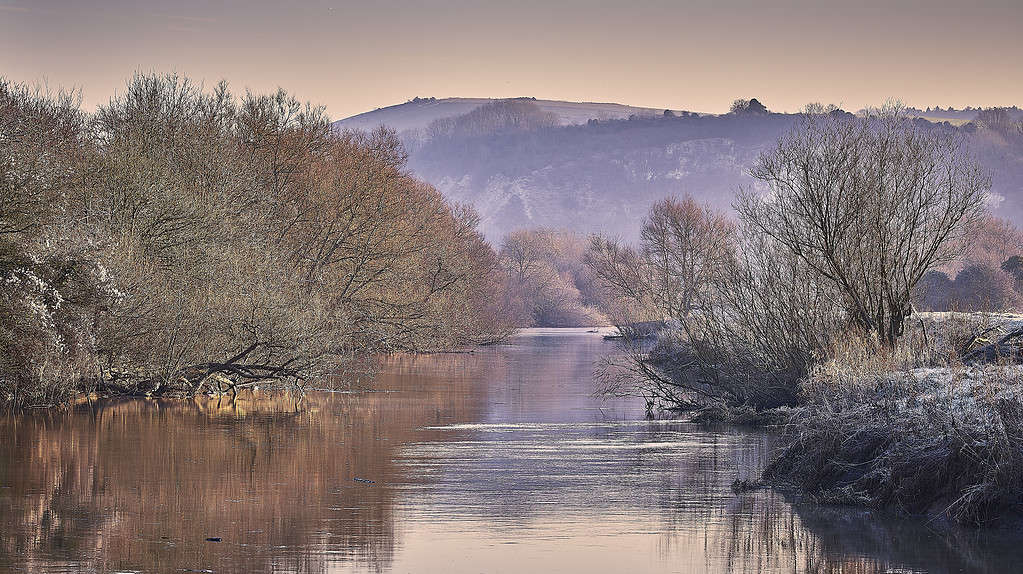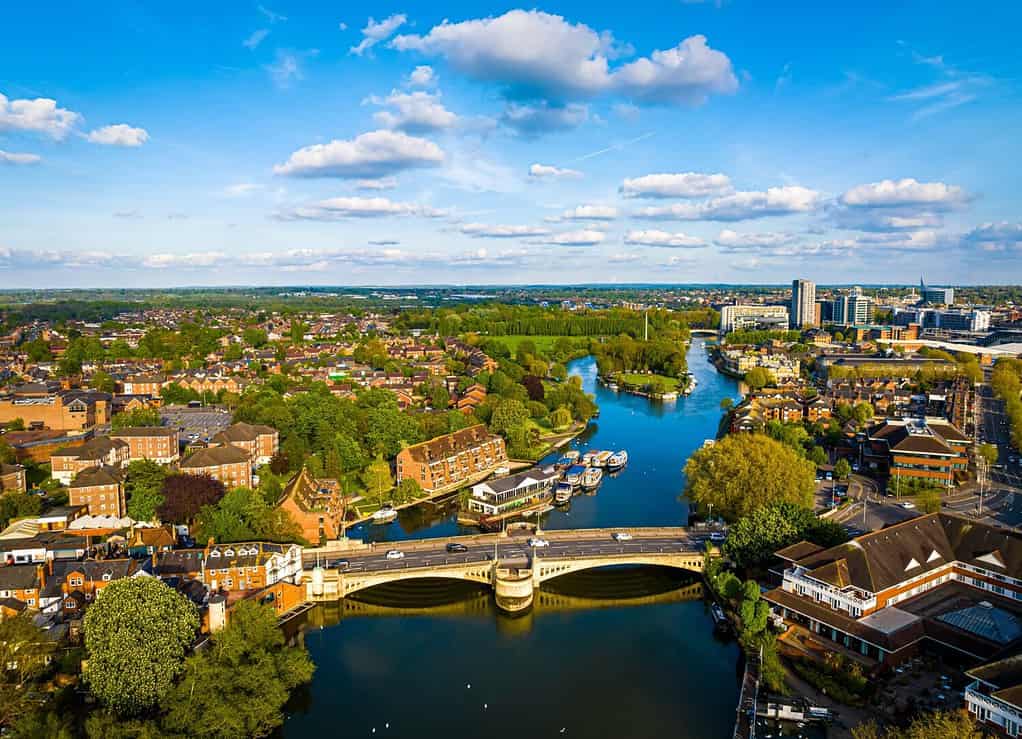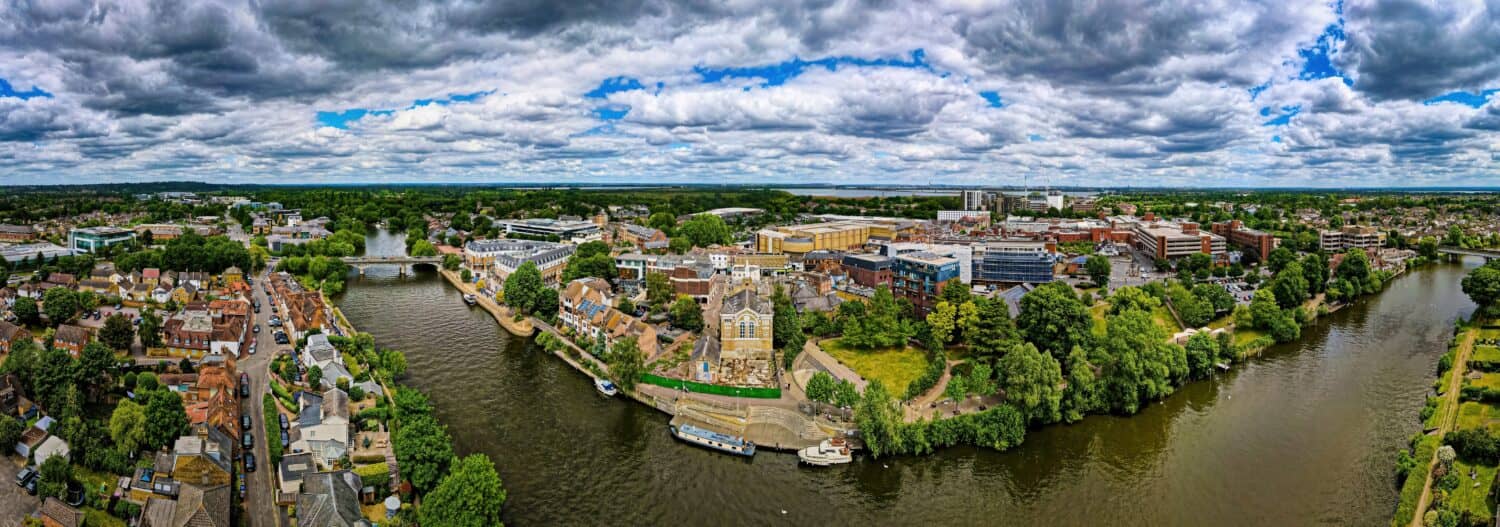Even though it is a small country by area, England has a long and rich history as well as a spectacular natural landscape. There are as many as 1,500 rivers in the United Kingdom, which includes England, Scotland, Wales, and Northern Ireland. Many of these played major roles in the trade and growth of towns and cities through the centuries. Castles dating back to the early 11th century are preserved on the banks of some, while others have major sites of government right along their waters.
#1 River Swale

Fly fishermen in the River Swale near Richmond in North Yorkshire, England
©Glen_Pearson/iStock via Getty Images
This river is located in North Yorkshire, England, and is considered the fastest flowing in the country. The name Swale actually means “tumultuous” in Olde English, which is fitting given how quickly the water moves in the river. It is roughly 60 miles long and connects to the River Ouse, which joins with other rivers at the River Humber and eventually discharges at the North Sea. There are four smaller tributaries that flow into the Swale. These include Arkle Beck, Bedale Beck, the River Wiske, and Cod Beck.
The dale or valley associated with the river is the Swaledale and is known for its natural beauty. It is a heavily wooded area that is very picturesque, especially when you consider the presence of nearby castles and estates. One in Richmond, which is the largest city on the river, dates back to 1071. The Keep is still intact and open for visitors. It is the best-preserved Norman castle in the entire country, an important site for historians and the general public.
The River Swale can rise as much as 9 feet in an hour, depending on the rainfall and conditions. This has resulted in significant erosion of the areas around the river, which respond to the fast-moving water. The area is home to a lot of wildlife, including interesting animals and plants. The Swale has plenty of kingfishers and plovers along its banks. Brown trout, bream, perch, and pike are all found in various sections of the river. It is a popular place for fishing, although you should take care to check the river conditions before venturing out into its potentially fast-moving water.
#2 River Arun

The idyllic countryside location is characteristic of the River Arun.
©Matthew J Thomas/iStock via Getty Images
The River Arun is in West Sussex and is around 37 miles long. It is close to the shore and very tidal, causing it to run quite fast. The River Arun is often categorized as the second-fastest river in the country behind the River Swale. It is tidal as far as 25 miles away from the actual shore at Pallingham Quay.
The river is joined by the River Rother and flows through Arundel, a town in West Sussex that shares its name with the river. Eventually, the River Arun reaches the English Channel at the port town of Littlehampton. This small seaside town is known as a beach destination, with visitors from all around England, the UK, and beyond coming to visit. It is around 50 miles away from London and less than 20 miles from the nearby seaside resort town of Brighton.
The original name of the river when recorded by Claudius Ptolemy, a geographer and academic from Alexandria, in 150 AD was Trisantonis. This likely meant “the trespasser” in the Celtic language spoken in the region at the time. The name referred to the frequent flooding that the river experienced. It was called numerous things over the years, including the Arnus, meaning run or go, the River of Arundel, and the Tarrant.
The river was an important route for trade over many centuries, with added locks and channels to allow traffic up the river. Although improvements from the 1500s opened the river for more shipping, it wasn’t until the late 1700s that significant improvements brought a lot of shipping further north. In the mid-1800s, railroads overtook the need for river access and many of the canals were no longer used. Some non-profits and other organizations promote environmental stewardship of the area and the river while also maintaining the facilities and waterways as they are now.
#3 River Thames

Many towns and cities were built along the River Thames due to its importance as a shipping and trade route, including Reading in Southern England.
©Alexey Fedorenko/Shutterstock.com
This is one of the most recognizable rivers in England and also one of the fastest and widest. It is 215 miles long, the longest river that runs entirely through England. It flows through the center of London and features many notable sites on its banks. These include Big Ben, the London Eye, the Tower of London, the Palace of Westminster, and Tower Bridge. The London section of the river is tidal and can rise and fall as much as 23 feet.
Some portions flowing west are called the River Isis, which is marked on some maps. It eventually flows into the North Sea through the Thames Estuary in Essex and Kent. The port cities of Tilbury, Essex and Gravesend, Kent are on opposite shores of the Thames where it meets the North Sea.
There are many locks throughout the Thames, making it suitable for navigation and shipping. The river also has as many as 50 smaller tributaries that range from other major rivers to small streams. Covering such a significant portion of the country, it’s not surprising that it also plays an important role in the ecosystem. The North Kent Marshes are in the Thames Estuary and are important to migratory birds as well as other animals.
If you want to see beautiful views of the river as you explore, consider a walk along the Thames Path National Trail. This trail begins near Kemble where the river originates and goes for 185 miles. It ends at the Woolwich Foot Tunnel near London. It is a long and scenic walking or cycling trail, although some parts can be closed for biking due to flooding.
#4 River Severn

The River Severn flows through England and Wales.
©Ian Luck/Shutterstock.com
Another major river in the United Kingdom, the River Severn is actually longer the the River Thames overall. However, the Thames is the longest river that is located just in England. The River Severn flows through England and Wales. At 220 miles long, it is the longest river in the UK. It also flows fast, often reaching flow rates of over 3,000 cubic feet per second. The river begins in Wales in the Cambrian Mountains. It has a most forceful discharge into the Severn Estuary. From there, it discharges into the Bristol Channel. This body of water separates England and Wales. From there, it flows into the Celtic Sea and eventually into the Atlantic Ocean.
Shipping traffic was important to the river and the region. Moving iron and coal from the Midlands to the Bristol Channel was key. Many of the towns and cities around the River Severn developed because of this industry. Today, much of these goods move by railway instead. Recreational and pleasure boats are more common in the Severn today.
The river is prone to flooding. Many towns and cities along its banks experience flooding. This ranges from minor to catastrophic, causing more than $14 million of damage. There are some flood management practices in place now to minimize the flooding and impact, although it still happens. Barriers along major points of flooding help but residents are still used to frequent flood warnings and alerts. Heavy rain tends to be the biggest contributor to flooding that can impact residents and businesses.
Summary of the Fastest Rivers in England
| Number | River | Length (in miles) |
| 1 | River Swale | 60 |
| 2 | River Arun | 37 |
| 3 | River Thames | 215 |
| 4 | River Severn | 220 |
Thank you for reading! Have some feedback for us? Contact the AZ Animals editorial team.








